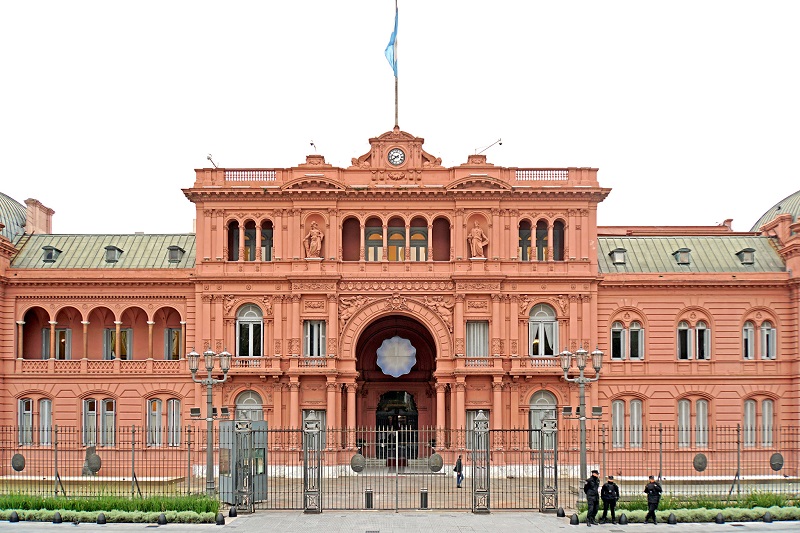ISABEL RUBIO ARROYO | Tungsteno
Did you know that the Casa Rosada is not symmetrical due to the demolition of one of its parts? Why does it have a room full of false doors? What is the reason for its pink colour? We investigate the secrets of Argentina's seat of government, which was almost fitted with a great dome and hides priceless archaeological remains inside.
An asymmetrical masterpiece
The Casa Rosada is located in the historic centre of the Autonomous City of Buenos Aires. Its history begins in 1873, when the Palacio de Correos y Telégrafos (Palace of Posts and Telegraphs) was erected. A few years later, President Julio Argentino Roca dreamed of a definitive government palace. He designed it next to the Palacio de Correos. In 1886, the two buildings were joined by the majestic portico that now greets the Plaza de Mayo. Thus was born the Casa Rosada. More than half a century later, in 1938, the south wing was demolished, as a result of which the Casa Rosada is no longer symmetrical.
A hall full of false doors
The White Hall is where the most important acts of government take place. It is where official ceremonies are held, foreign dignitaries are received and important decisions for Argentina are made, such as the signing of international treaties. The balcony or high gallery that surrounds it hides a secret: it is adorned with false doors covered with mirrors. The aim is to create a sense of greater breadth and depth, enhancing the grandeur of the space. “Only one of the doors opens, the one located in the centre of the right-hand sector leading into the hall,” says the official website of the Casa Rosada.
The White Hall is the main hall of the Casa Rosada. Credit: Casa Rosada official website.
The mystery of its colour
The choice of pink for this emblematic building is often attributed to President Domingo Faustino Sarmiento. It is said that Sarmiento, who assumed the presidency in 1868, used the mixture of white and red to symbolise the union of all the political sectors of the time. “According to some versions, the original method used to obtain the characteristic pink colour of the Casa de Gobierno was to mix lime with cow’s blood, a common technique at the time due to the water-repellent (to avoid moisture and filtrations) and fixing properties of the blood,” says the official website.
The dome that never was
The Casa Rosada was on the verge of having a majestic dome on its west façade. In 1907, the General Directorate of Architecture presented a project to transform the building's appearance. The idea was to construct a great dome that would symbolise grandeur and modernity. In the end, however, the project was never carried out. The reasons why it was left on the back burner of history are not documented.
The Casa Rosada was on the verge of having a majestic dome. Credit: Casa Rosada official website
The buried past of the Casa Rosada
At the beginning of the 20th century, excavations were carried out in the Patio de las Palmeras of the Casa Rosada and an unexpected discovery was made: rounded stones that, according to the renowned archaeologist Juan Bautista Ambrosetti, could be instruments used by the indigenous people of the area. Specifically, he suggested that they could be stones from boleadoras (a throwing weapon used mainly for hunting) or hatchets used by the Querandí people, indigenous South Americans who inhabited the Pampean region of present-day Argentina.
These are not the only mysteries hidden in the Casa Rosada. In fact, other surprising discoveries have been made under its floors. Most recently, in 2018, during the excavation of a pit for the installation of new lifts, ruins were found three metres underground. They belong to the Palace of the Viceroys of the Río de la Plata and date back to the 18th century. All these curiosities make the Casa Rosada more than just a government building. It is a unique place that attracts millions of tourists every year for its historical, cultural and architectural value.
Tungsteno is a journalism laboratory to scan the essence of innovation.
